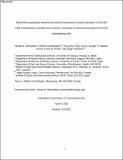Files in this item
Experiments quantifying elemental and isotopic fractionations during evaporation of CAI-like melts in low-pressure hydrogen and in vacuum : Constraints on thermal processing of CAI in the protoplanetary disk
Item metadata
| dc.contributor.author | Mendybaev, Ruslan A. | |
| dc.contributor.author | Kamibayashi, Michiru | |
| dc.contributor.author | Teng, Fang-Zhen | |
| dc.contributor.author | Savage, Paul S. | |
| dc.contributor.author | Bastian Georg, R. | |
| dc.contributor.author | Richter, Frank M. | |
| dc.contributor.author | Tachibana, Shogo | |
| dc.date.accessioned | 2021-09-15T23:42:25Z | |
| dc.date.available | 2021-09-15T23:42:25Z | |
| dc.date.issued | 2021-01-01 | |
| dc.identifier | 270229682 | |
| dc.identifier | 5939263b-990e-4e1d-8503-eac172691841 | |
| dc.identifier | 85092267867 | |
| dc.identifier | 000590778600016 | |
| dc.identifier.citation | Mendybaev , R A , Kamibayashi , M , Teng , F-Z , Savage , P S , Bastian Georg , R , Richter , F M & Tachibana , S 2021 , ' Experiments quantifying elemental and isotopic fractionations during evaporation of CAI-like melts in low-pressure hydrogen and in vacuum : Constraints on thermal processing of CAI in the protoplanetary disk ' , Geochimica et Cosmochimica Acta , vol. 292 , pp. 557-576 . https://doi.org/10.1016/j.gca.2020.09.005 | en |
| dc.identifier.issn | 0016-7037 | |
| dc.identifier.other | RIS: urn:94BAB54FB1B7E203398E63F922C2B0AD | |
| dc.identifier.other | ORCID: /0000-0001-8464-0264/work/80620670 | |
| dc.identifier.uri | https://hdl.handle.net/10023/23969 | |
| dc.description | This work was supported by NASA grant NNX17AE84G (to R.M.). Magnesium isotopic measurements were supported by NSF grant EAR-17407706 (to F.-Z. T.). P.S. and the Si isotope measurements made at the St Andrews Isotope Group (STAiG) at the University of St Andrews were supported by NERC grant NE/R002134/1 a Carnegie Trust Research Incentive Grant. Evaporation experiments at Hokkaido University were supported by the Ministry of Education, Sports, Science, and Technology KAKENHI Grant (to S.T.). | en |
| dc.description.abstract | It is widely believed that the precursors of coarse-grained CAIs in chondrites are solar nebula condensates that were later reheated and melted to a high degree. Such melting under low-pressure conditions is expected to result in evaporation of moderately volatile magnesium and silicon and their mass-dependent isotopic fractionation. The evaporation of silicate melts has been extensively studied in vacuum laboratory experiments and a large experimental database on chemical and isotopic fractionations now exists. Nevertheless, it remains unclear if vacuum evaporation of CAI-like melts adequately describes the evaporation in the hydrogen-rich gas of the solar nebula. Here we report the results of a detailed experimental study on evaporation of a such melt at 1600°C in both vacuum and low-pressure hydrogen gas, using 1.5- and 2.5-mm diameter samples. The experiments show that although at 2×10−4 bar H2 magnesium and silicon evaporate ∼2.8 times faster than at 2×10−5 bar H2 and ∼45 times faster than in vacuum, their relative evaporation rates and isotopic fractionation factors remain the same. This means that the chemical and isotopic evolutions of all evaporation residues plot along a single evaporation trajectory regardless of experimental conditions (vacuum or low-PH2) and sample size. The independence of chemical and isotopic evaporation trajectories on PH2 of the surrounding gas imply that the existing extensive experimental database on vacuum evaporation of CAI-like materials can be safely used to model the evaporation under solar nebula conditions, taking into account the dependence of evaporation kinetics on PH2. The experimental data suggest that it would take less than 25 minutes at 1600°C to evaporate 15–50% of magnesium and 5–20% of silicon from a 2.5-mm diameter sample in a solar nebula with PH2∼2×10−4 bar and to enrich the residual melt in heavy magnesium and silicon isotopes up to δ25Mg ∼ 5–10‰ and δ29Si ∼ 2–4‰. The expected chemical and isotopic features are compatible to those typically observed in coarse-grained Type A and B CAIs. Evaporation for ∼1 hour will produce δ25Mg ∼30–35‰ and δ29Si ∼10–15‰, close to the values in highly fractionated Type F and FUN CAIs. These very short timescales suggest melting and evaporation of CAI precursors in very short dynamic heating events. The experimental results reported here provide a stringent test of proposed astrophysical models for the origin and evolution of CAIs. | |
| dc.format.extent | 1586230 | |
| dc.language.iso | eng | |
| dc.relation.ispartof | Geochimica et Cosmochimica Acta | en |
| dc.subject | CAI evaporation | en |
| dc.subject | Experiments | en |
| dc.subject | Kinetics | en |
| dc.subject | Elemental fractionation | en |
| dc.subject | Isotopic fractionation | en |
| dc.subject | Magnesium | en |
| dc.subject | Silicon | en |
| dc.subject | Timescales | en |
| dc.subject | Astrophysical models | en |
| dc.subject | Nebular shock | en |
| dc.subject | GE Environmental Sciences | en |
| dc.subject | NDAS | en |
| dc.subject.lcc | GE | en |
| dc.title | Experiments quantifying elemental and isotopic fractionations during evaporation of CAI-like melts in low-pressure hydrogen and in vacuum : Constraints on thermal processing of CAI in the protoplanetary disk | en |
| dc.type | Journal article | en |
| dc.contributor.sponsor | NERC | en |
| dc.contributor.institution | University of St Andrews. School of Earth & Environmental Sciences | en |
| dc.contributor.institution | University of St Andrews. St Andrews Centre for Exoplanet Science | en |
| dc.contributor.institution | University of St Andrews. St Andrews Isotope Geochemistry | en |
| dc.identifier.doi | 10.1016/j.gca.2020.09.005 | |
| dc.description.status | Peer reviewed | en |
| dc.date.embargoedUntil | 2021-09-16 | |
| dc.identifier.grantnumber | NSF | en |
This item appears in the following Collection(s)
Items in the St Andrews Research Repository are protected by copyright, with all rights reserved, unless otherwise indicated.

